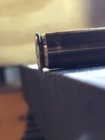coldboreshot
Silver $$ Contributor
I'm having issues chambering resized brass out of my pre-64 M70 .220 Swift and cannot narrow down the cause.
I had reloaded once fired Hornady brass and noticed while at the range, some of them would not chamber in my M70. I figured I didn't have my FL sizing die turned down far enough. I did fire the rounds out of another .220 Swift later. I then cleaned the brass, ran a few through the FL sizing die, measured headspace with a comparator, and proceeded to test. They would not chamber. I then incrementally started to turn the die down to the point where I can no longer turn it down and still get cam over. Still will not chamber.
Fortunately, I was able to find a piece brass that was 1x fired and would chamber easily in the rifle. I proceeded to take measurements of that case and the other cases I had used to test that would not chamber.
Good Case
Bad case
- Headspace = 1.728
- Case length = 2.196
- Case width at base= 0.442
- Case width at mid point = 0.425
- Case width just below neck = 0.405
In every way I measured, it seems the bad case is smaller so I cannot figure out why it won't chamber but the other case will.
- Headspace = Started at 1.728, took it all the way down to 1.722
- Case length = 2.196
- Case width at base= 0.440
- Case width at mid point = 0.425
- Case width just below neck = 0.404
I'm guessing it might have something to do with the brass having been fired out of two different rifles but considering all the brass went through the FL die anyway, I'd think it would get it consistent. Both the good and bad cases all chamber in the other rifle, which is a Ruger No1.
What am I missing!?!?
Get yourself a chamber length plug from Sinclair Intnl and measure the chamber length. Even though the case lengths are the same and it works in one rifle's chamber, the other chamber may be slightly shorter and the case is jammed against the front edge. This could have been the cut of the reamer for that chamber. A sizing die is not going to touch the case length. Or, if you have a case trimmer, start with .001" increments and find at what length the case chambers. I'm betting, the chamber is a little short, not so much tight.











